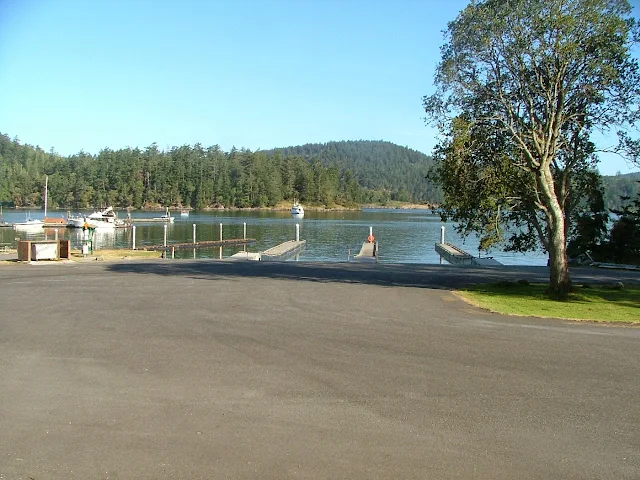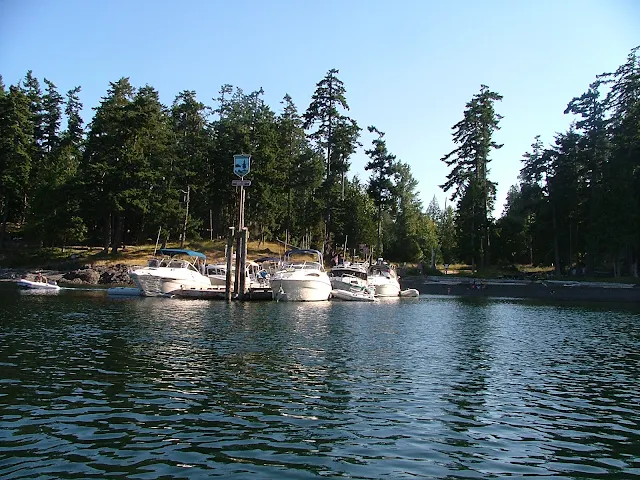We all know asking "What's the best dinghy" is a loaded question; boaters can be passionate when it comes to equipment choices. Based on my own frugal,
sailing/boating should be affordable philosophy "The best dinghy is the one you already own." Whoa now, lets start listing exceptions. I don't mean too small, too big, leaky, unsafe, etc. etc. I mean a basic dinghy, that only has to float you and your stuff to shore.
In keeping with this blogs purpose to help first timers get to the San Juans, lets talk reality.
Here are ten or more irrefutable truths about dinghies.
- You must have a dinghy to go ashore at most parks, because you can't count on there being room at the dock. Many docks have room for only four boats. Many parks have no dock.
- You don't need a dinghy if you only go to resorts and marinas.
- You will probably tow your dinghy everywhere you go.
- You may not use it at all (makes you wish you left it home).
- If you need it you will be thankful you brought it with you.
- There is no place you will go that you can't drag your dinghy along.
- Dinghies may be major status symbols among some groups.
- Towing a dinghy slows you down and uses fuel
- You may run over your tow line and foul your prop or rudder (use a floating tow line).
- Certain people have a hard time climbing into or out of a dinghy alongside their boat.
- Children need a dinghy.
Okay, that list is far from complete but highlights some points. Yes you need a dinghy, even if you can beach your boat, there are simply too many limitations and problems with beaching your water borne camper. Lets say for example you rush to shore to use the bathroom at one of the great State Parks. In the ten minutes you're ashore, a falling tide could leave you high and dry. With a dinghy you simply pick it up and carry it back to the water. You need a two or three person dinghy, a one person craft can't ferry others to shore. When using dinghies, a multi hull catamaran style such as a Livingston is very stable, rows well, beaches easy, and can carry big cargoes, however when towed they track to one side, hunt back and forth, forcing you to keep them on a very short leash. A conventional V hull dinghy is tipsy crawling over the bow on the beach, carry's less cargo, but rows very nice and will tow directly behind you on a long or short leash. Inflatables can carry enormous loads, some (not all) row poorly and some create so much drag they are impossible to tow. Just about all dinghies can be outfitted with an outboard motor, but you really don't need one for simple cruising in the San Juan Islands unless you plan on doing miles of shoreline exploring.
In the summer season you probably wont see any big dinghy capsizing waves, but storms and adverse winds can churn up anywhere anytime, my dinghy floats when swamped, but not with the outboard, with the outboard bolted to the transom it's straight to the bottom or at least as far down as my tow line is long. Inflatables may be swamped without damage or sinking, which is something to think about if your main boat is not up to the challenge, and could itself be sunk somehow.
 |
| Our Livingston dinghy is nine feet long and a tad bit overloaded |
 |
| This inflatable was $69 and holds two people |
 |
| This inflatable stows on deck, or deflated stows below and carries three people. |
How about two dinghy's?
If you have children that take off with the dinghy, they are effectively leaving you stranded on the boat or ashore. Well that's not going to happen you may say. I say, "what if they get hurt ashore and call you on the phone or radio for help? What do you do? What if they take off in the dinghy and it gets dark, what do you do? (swim)"
Several years past I sent my bored and restless son (in the dinghy) to shore at dusk, telling him to invite himself to one of the many campfires we could see from the boat. He met some other boaters with kids and before you know it it was after 10:00 pm and very dark. His mother and I started to wonder what to do as we were stranded, and had no way to communicate with him. After a few minutes I took a strong flash light and blinked it into the darkness in the direction we thought he was last seen. A short while later he appeared at our transom asking if we wanted him or something. This little non event made me realize how handy a second dinghy would be, so we bought an inflatable kayak to stow below, just in case.
10/13/13 update worth noting
I'm selling the new sailing dinghy
4/17/17 update on converting the 9' Livingston dinghy to sailing
>> go to the do-it-yourself page and scroll way way way down to see the finished conversion << The dinghy conversion section is before the Bimini top on the cheap instructions and after the Boat acronyms if that helps you find it.
Livingston dinghy sailing conversion
9/13/20 another dinghy update. Last winter I plunked down about a grand in boat bucks and bought a new inflatable. My criteria was as follows. First, it must be light enough for me to muscle it around onto and off of the cabin roof by myself. It must have two seats. I must be able to inflate and deflate it on the boat. I bought a 9.5 foot boat with aluminum seats, plywood transom and high pressure inflatable floor. Without seats, oars or pump, the rolled up package is about 4 feet long, 1.5 feet in diameter and weighs in at 73 pounds.
Standing on the cabin roof, I was able to fully inflate the new boat and slide it into the water. Dragging it back up was much more work, even with two of us. Then we drove around for three days with the inflated boat on the roof. All in all I like the new boat and am happy with my choice.
Testing complete, we deflated our new dinghy, rolled it up and headed for the San Juans. At the last minute before heading up the freeway, I put the Livingston back on it's swim step snap davits. I know my plan was to replace the Livingston with something more seaworthy but I decided to bring the new and the old anyway.
In the San Juans we never inflated the new dinghy, and used the Livingston as usual. Now the new inflatable is sitting collecting dust in my boat shed. I used it once for one hour. I still have high hopes to somehow justify my purchase. I hope mice and squirrels don't chew on it in the meantime.











































